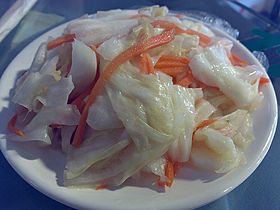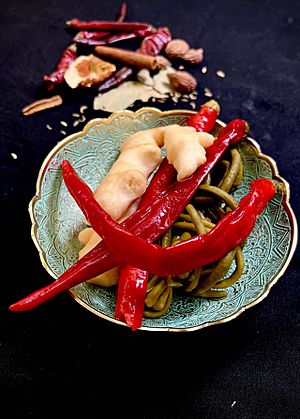Pao cai facts for kids
Quick facts for kids Pao cai |
|||||||||||||
|---|---|---|---|---|---|---|---|---|---|---|---|---|---|
 |
|||||||||||||
| Chinese | 泡菜 | ||||||||||||
| Hanyu Pinyin | pàocài | ||||||||||||
| Literal meaning | pickled vegetable | ||||||||||||
|
|||||||||||||
Pao cai (Chinese: 泡菜; pinyin: pàocài; Wade–Giles: p'ao4 ts'ai4), sometimes called Pao tsai, is a type of fermented vegetable from China. You might also hear it called Chinese pickles or Chinese sauerkraut. It's made by fermenting different vegetables like Chinese cabbage, radish, and peppers. These vegetables are placed in a special jar with a salty liquid called brine.
To make it taste even better and to help keep it fresh, people often add ingredients like garlic, ginger, chili, and cloves. Pao cai is especially famous in Sichuan cuisine in China. It's very common in northern and western China. There's also a special kind called suan cai that's popular in Northeastern China. People usually eat pao cai with rice, often with congee (a type of rice porridge) for breakfast. There are more than 11 different kinds of pao cai in China!
Similar fermented vegetables are found all over the world. Some examples include Sichuanese zha cai, Central American curtido, French cornichons, and German sauerkraut.
Contents
History of Pao Cai
For a very long time, vegetables have been a key food source for people. To make sure there was enough food all year, ancient Chinese people needed ways to store vegetables after harvest. They learned to preserve fresh vegetables using salt, pickling them in earthen jars. These early salted vegetables were the first versions of pao cai. It's a very old way of preserving food in China, and it's still important today.
The oldest collection of poems in China, called the Shijing, mentions pickled vegetables. The word "葅" from that time refers to what we now call pao cai. Over many centuries, during dynasties like the Zhou, Northern Wei, Tang, Song, Yuan, and Ming, there are historical records and books that talk about pao cai.
By the Qing Dynasty (1644-1911), pao cai had developed a lot, with many different kinds, including Sichuan pao cai. During the Qing Dynasty, pao cai was even given as a dowry (a gift from the bride's family) in some parts of Sichuan. This tradition still exists in some areas, showing how important pao cai has been in people's lives for a very long time.
Throughout its history in China, Sichuan pao cai has been especially well-known. This is because the climate and soil in Sichuan are perfect for growing the vegetables used to make it. Also, the way it's made, the special jars used for fermenting, and its popularity have all made Sichuan pao cai very famous.
Types of Pao Cai
Sichuan Pao Cai
Sichuan pao cai (Chinese: 四川泡菜) is a very famous type of Chinese fermented vegetable. It's mostly made and eaten in southwestern China. Its history goes back to the Shang Dynasty, over three thousand years ago! Sichuan pao cai is a big part of Sichuan cuisine. People use it as a side dish, an appetizer, or even a seasoning. It's loved for its crunchy texture, special smell, and health benefits from the lactic acid fermentation. You can find Sichuan pao cai made at home by families and also produced in factories across China.
How Sichuan Pao Cai is Made
Sichuan pao cai is usually made from fresh or lightly salted vegetables like radish, carrot, and cowpea. These vegetables are fermented naturally at room temperature. Tiny living things called microbes, mainly lactic acid bacteria (LAB), do most of the work. These bacteria grow very well in the conditions used for fermentation.
The vegetables are soaked in a salty liquid (brine) that has about 6–8% salt. Flavorings like ginger, chili, Sichuan pepper, and garlic are added. Many local people in Sichuan use "aged" pao cai brine. This means they reuse the brine from previous batches, sometimes for many years or even decades! This aged brine is full of lactic acid bacteria, which helps new batches ferment quickly and correctly.
When people make pao cai at home, they use special jars. The top of the jar has a groove or "eave-like" circle around it. The lid sits upside down on top of the jar. This groove is filled with water, which creates a seal. This seal keeps air out, making an anaerobic (no-oxygen) environment that's perfect for the lactic acid bacteria. Any gas produced by the microbes during fermentation can escape by dissolving in this water. Many families in Sichuan have these special pao cai jars in their homes.
In factories, Sichuan pao cai is made in a few ways. Some are "fermented pickles," soaked in salt water, then liquid is added. Others are "instant pickles," which are soaked, then shaped, desalted, flavored, packaged, and sterilized. There are also "other pickles" that might use different ingredients like mushrooms or seaweed along with traditional vegetables.
Pao Cai Industry in Sichuan
The pao cai industry in China has grown very quickly. Many pao cai companies are located in the Sichuan region. In 2018, the value of Sichuan pao cai produced was about 33 billion yuan. This was more than 70% of the total value of pao cai made in all of China! A city called Meishan in Sichuan produced a huge amount, about 16 billion yuan worth, which was almost half of Sichuan's total.
International Standard for Pao Cai
On November 24, 2020, an international group called the International Organization for Standardization (ISO) created a worldwide standard for the pao cai industry. This standard was developed with leadership from China, specifically from the Meishan Municipal Bureau of Market Supervision in Sichuan Province.
The ISO standard set clear definitions for the "categories" and "requirements" of pao cai. The main goal was to make it easier to trade and sell pao cai around the world. It helps ensure that pao cai products have consistent quality and safety. The ISO standard used the name pao cai (the Mandarin Chinese name) for these fermented vegetables. It also clearly stated that this document "does not apply to kimchi," which is a different type of fermented vegetable.
See also
 In Spanish: Pao cai para niños
In Spanish: Pao cai para niños



